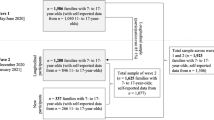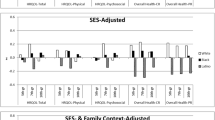Abstract
Background: Health-related quality of life in adolescents and ethnic and cultural differences are not well characterized. We used the Quality of Life Questionnaire for Adolescents (QOLQA) to examine ethnic differences in reported QOL scores among Chinese, Malay and Indian ethnicities in Singapore. Methods: The 70-item QOLQA measuring five QOL domains (physical, psychological, independence, social and environmental) was administered to a random sample of 1363 school-children aged 10–15 years, representative of the ethnic composition of Singapore adolescents (Chinese 72%, Malays 20% and Indians 8%). Results: Indians reported the highest overall QOL (mean 3.71 ± SD 0.54) compared to Chinese (3.59 ± 0.43), p <0.05, and Malays (3.58 ± 0.44), p < 0.05. In particular, Indians had significantly higher psychological QOL scores (3.73 ± 0.61) compared to Chinese (3.55 ± 0.54), p < 0.01. On the other hand, Chinese scored highest on physical and independence domains (3.97 ± 0.54), p < 0.01 compared to Malays (3.82 ± 0.55). There were no statistically significant gender differences in QOL scores. QOL declined significantly from age 10 to 15 for overall score, psychological, physical (p < 0.01) and environmental (p < 0.05). Lower socio-economic status and the self-report of a significant health problem were significantly associated with lower overall QOL and most domains. These ethnic differences persisted after adjusting for differences in socio-economic and health status. Psychometric properties and known group construct validity appeared to be similar across different ethnic groups, but compared to Chinese (r = 0.39) or Malays (r = 0.39), Indians showed a higher correlation of psychological scores with physical score (r = 0.59) and with other domain scores. Conclusion: Significant ethnic differences in reported adolescent quality of life among Chinese, Malays and Indians in Singapore that are independent of socio-economic and health status suggest important cultural differences.
Similar content being viewed by others
References
R. Schabas (1992) Opportunities for Health. Ontario. Ministry of Health Toronto
P. Rosenbaum et al. (1990) Pediatrics: Assessing quality of life B. Spilker (Eds) Quality of Life Assessments in Clinical Trials. Raven Press New York 205–215
JM Landgraf et al. (1996) The Child Health Questionnaire (CHQ): A User’s Manual The Health Institute Boston, MA.
WL Stone KL. Lemanek (1990) Developmental issues in children’s self-reports AM. La Greca (Eds) Through the Eyes of the Child: Obtaining Self-reports from Children and Adolescents. Allyn & Bacon Boston 18–56
X Wang N Matsuda H Ma N. Shinfuku (2000) ArticleTitleComparative study of quality of life between the Chinese and Japanese adolescent populations Psychiatry Clin Neurosci. 54 IssueID2 147–152 Occurrence Handle10803807
S Schmidt M. Bullinger (2003) ArticleTitleCurrent issues in cross-cultural quality of life instrument development Arch Phys Med Rehabil. 84 IssueID4 Suppl 2 S29–S34 Occurrence Handle12692769
NB Anderson CA. Armstead (1995) ArticleTitleTowards understanding the association of socioeconomic status and health: A new challenge for the biophysical approach Psychosom Med. 57 213–225 Occurrence Handle7652122
BE Meyerowitz J Richardson S Hudson B. Leedham (1998) ArticleTitleEthnicity and cancer outcomes: Behavioural and psychological considerations Psychol Bull. 13 IssueID1 47–70
PA Johnson L Goldman EJ Orav et al. (1995) ArticleTitleComparison of the medical outcome study short-form 36-item health survey in Black patients and White patients with acute chest pain Med Care. 33 IssueID2 145–160 Occurrence Handle7837823
K Ashing-Giwa PA Ganz L. Petersen (1999) ArticleTitleQuality of life of African-American long term breast carcinoma survivors Cancer. 85 IssueID2 418–426 Occurrence Handle10023710
S Tennstedt BH. Chang (1998) ArticleTitleThe relative contribution of ethnicity versus socioeconomic status in explaining differences in disability and receipt of informal care J Gerontol Ser B, Psychol Sci Soc Sci. 53 IssueID2 S61–S70
SM Skevington et al. (1999) ArticleTitleSelecting national items for the WHOQOL: Conceptual and psychometric considerations Soc Sci Med. 48 473–487 Occurrence Handle10075173
The WHOQOL Group. The World Health Organization quality of life assessment (WHOQOL): Development and general psychometric properties. Soc Sci Med 1998; 46(12): 1569–1585
H Ma CD Wang N Shinfuku et al. (1999) ArticleTitleValidity and reliability of QOL questionnaire for adolescents (Chinese version) Chin Mental Health J. 13 18–19
K Burstorm et al. (2001) ArticleTitleHealth-related quality of life by disease and socio-economic group in the general population in Sweden Health Policy. 55 IssueID1 51–69 Occurrence Handle11137188
BH Wai C Hong KE. Heok (1999) ArticleTitleSuicidal behavior among young people in Singapore Gen Hosp Psychiatry. 21 IssueID2 128–133 Occurrence Handle10228894
EK. Ung (2003) ArticleTitleYouth suicide and parasuicide in Singapore Ann Acad Med Singapore. 32 IssueID1 12–18 Occurrence Handle12625092
J Thumboo et al. (2003) ArticleTitleQuality of life in an urban Asian population: the impact of ethnicity and socio-economic status Soc Sci Med. 56 1761–1772 Occurrence Handle12639592
LL Hourani et al. (1986) ArticleTitleDeterminants of perceived mental health status and help-seeking behavior: Preliminary testing of a conceptual model Soc Sci Med. 22 IssueID10 1081–1086 Occurrence Handle3738554
CG. Helman (1990) Culture, Health and Illness: An Introduction for Health Professionals Wright London.
A. Kleinman (1987) ArticleTitleAnthropology and psychiatry: The role of culture in cross-cultural research on illness Cult Med Psychiatry. 151 447–454
D Raphael E Rukholm I Brown et al. (1996) ArticleTitleThe quality of life profile – adolescent version: Background, description, and initial validation J Adolescent Health. 19 366–375
LT Berntsson L. Kohler (2001) ArticleTitleQuality of life among children aged 2–17 years in the five Nordic countries. Comparison between 1984 and 1996 Eur J Public Health. 11 IssueID4 437–445 Occurrence Handle11766487
M Apajasalo H Sintonen C Holmberg et al. (1996) ArticleTitleQuality of life in early adolescence: A sixteen-dimensional health-related measure (16D) Qual Life Res. 5 IssueID2 205–211 Occurrence Handle8998489
S Haugland et al. (2001) ArticleTitleSubjective health complaints in adolescence. A cross-national comparison of prevalence and dimensionality. Eur J Public Health. 11 IssueID1 4–10 Occurrence Handle11276570
LT Berntsson L. Kohler (2001) ArticleTitleQuality of life among children aged 2–17 years in the five Nordic countries. Comparison between 1984 and 1996 Eur J Public Health. 11 IssueID4 437–445 Occurrence Handle11766487
D Raphael E Rukholm I Brown et al. (1996) ArticleTitleThe quality of life profile – adolescent version: Background, description, and initial validation J Adolescent Health. 19 366–375
Author information
Authors and Affiliations
Corresponding author
Rights and permissions
About this article
Cite this article
Ng, T.P., Lim, L.C.C., Jin, A. et al. Ethnic differences in quality of life in adolescents among Chinese, Malay and Indians in Singapore. Qual Life Res 14, 1755–1768 (2005). https://doi.org/10.1007/s11136-005-1741-2
Accepted:
Issue Date:
DOI: https://doi.org/10.1007/s11136-005-1741-2




